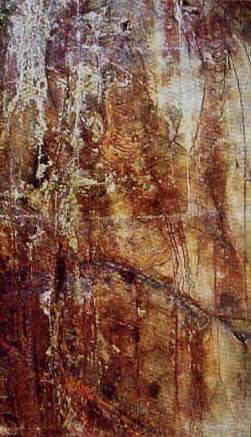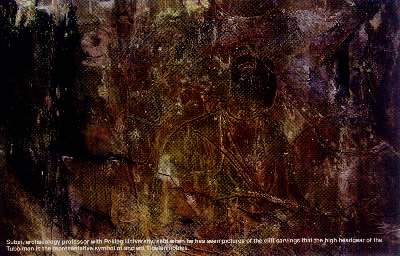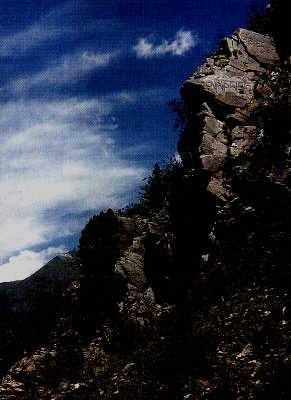
Editor's Note: Rock carvings existed in a beautiful mountain valley in Western China for some 1,300 years known only to a small number of people. But they do tell the history of ties between the Han and the Tibetan.
Mountain cliffs at the mouth of the Leba Gully in Qinghai Yushu Tibetan Autonomous Prefecture have, since ancient times, attracted visitors and scholars. On them are carved pictures of Tang Dynasty (618-907) women dressed in palace costumes and a man dressed in robes depicting the status of a Tubo noble. Flanking them are carved Buddhas and maids.
"The ears protruding from the head of that Tubo man are symbolic of ancient Tibetan nobles," said Subai, a noted professor in archaeology with Peking University, when he saw photos of these rock carvings.
"From the style of the carvings themselves, I would conclude that they were created in the mid-7th century, in the period when Buddhism was first being propagated in Tubo."

No written materials have so far been found to support the conclusion of Prof. Shu, but local Tibetans all argue that these rock carvings were authentic works of Princess Wencheng in 641, when she came to Tubo to marry Tubo King Songtsan Gambo. In order to secure the marriage, the Tubo King who unified the whole of Tubo in the early 7th century twice sent envoys to Chang'an (present-day Xi'an) beginning in 634 until Tang Emperor Taizong (Li Shimin) agreed.
Princess Wencheng journeyed from Chang'an to Lhasa, a distance extending some 3,000 km, via Xining in the west, where she crossed the Sun-Moon Mountain (a demarcation line between farming and pastoral areas) before crossing three grassless Gobi deserts in the south.
Legend has it that Songtsan Gambo made a special trip from Lhasa to Zhaling and Eling Lakes, both serving as sources of the Yellow River, to the north of Yushuu (in present-day Qinghai) to greet Princess Wencheng. They climbed up to the mouth of Bayankala Mountain, crossed the Tongtianhe River, on tributary on the upper reaches of the Yangtze River, and reached the said mountain gully abounding in emerald plants.
Though the gully has several names in written materials produced throughout history, local people of the Tibetan ethnic group in Gyigu Town, site of the Yushu prefectural government, call it Legba. Overwhelmed by the intoxicating scenery there, Princess Wencheng and Songtsan Gambo spent a month-long honeymoon in the gully. Believing she and her party enjoyed a safe trip because of protection from the deities, Princess Wencheng, who had worshipped Buddha ever since childhood, ordered human figures to be carved on the cliffs in the gully.
"This is obviously a portrait of Buddha worshipping," said Wen Yucheng, honorary director of the Luoyang Museum of Longmen Grottoes, who has a good command on Buddhist carving art of the Tang Dynasty.
Pointing to the halo surrounded the head of the three-meter Buddha figure in the picture he possessed of the gully cliff carvings, Director Wen said "According to Buddhism, only Buddha has such a halo".
In the cliff carvings, both men and women face a Buddha who is twice their height. All of them hold something in their hands. Some men have bowl-like utensils with a cover, and women each hold a flower in their hand.
"It should be a lotus," said Subai.
Given the fact that the cliff paintings have existed for more than 1,300 years, having experienced weather erosion during the period, two patronages in the cliff carvings show full sincerity to the Buddha who is benevolent and kind. Strong lines show that the Buddha wears a thin cloak.
"The cutting lines show a high artistic level and the standard of living enjoyed by people in that period," said Director Wen.
Because of lack of written materials, neither Subai nor Wen dares to say the two patronages in the cliff carvings imply Songtsan Gambo and Princess Wencheng. But they all say the carvings show the ties between the Han and Tibetan peoples in ancient times.
"The two are Princess Wencheng and King Songtsan Gambo,"Deyang, a 10-year-old fourth-grade student in Gyigu Town, said to visitors whom she brought to the cliff carvings.
"They are worshipping the Buddha," he added.

At the western mouth of the Legba Gully, which is some 20 km from where the cliff carvings are located, there is the Temple of Princess Wencheng. Small but famous, the temple was built to mark the segment of history Some 1,360 years ago, Princess Wencheng began to move out of the gully. When saying goodbye to Yushu, she found many locals who all had tears in their eyes.
"Princess Wencheng brought the seeds of cereals to the area," said Quying Lamze with the government of the Yushuu Prefecture.
"During her stay in the gully, she taught the locals how to grow vegetables and grind wheat flour. Her foot prints are left in the piece of rock on which she often stood, and it is the site worshipped also by the local people."
Talking about Buddhist sutras carved into rocks in the gully, the Tibetan government functionary said "They were carved by worshippers of later generation. They did it to show their respect for the Tubo king and the Tang princess."
Seventy years later (which means 30 years after Princess Wencheng passed away in Lhasa), another Tang Dynasty princess, Jincheng, was married into the Tubo in response to the request of the Tubo king. She followed the route traversed by Princess Wencheng. When told about her predecessor in the gully, Princess Jincheng ordered the building of the Temple of Princess Wencheng.

On the rocks behind the temple is a Diamond Sutra carved in Chinese and Tibetan. Most words of the sutra cannot be discerned today.
"It is rare to see a Buddhist scripture carved into rocks in both Chinese and Tibetan," said Li Zhixin, director of the Qinghai Provincial Museum.
"Due to lack of written materials, there is insufficient study of the rock carvings and carved sutra in the Legba Gully.
"I am really sorry for this. But we have made copies of the rock carvings which you could find in our museum"
